All about kitchen potholders

Mistresses are different. Someone likes to cook, some not so much, but in any case, in almost every kitchen you can see an oven mitt that makes cooking more comfortable. It would seem that such a simple item is quite easy to choose, however, potholders, like housewives, are different, and their choice should be approached responsibly, because the convenience and safety of cooking will depend on this.
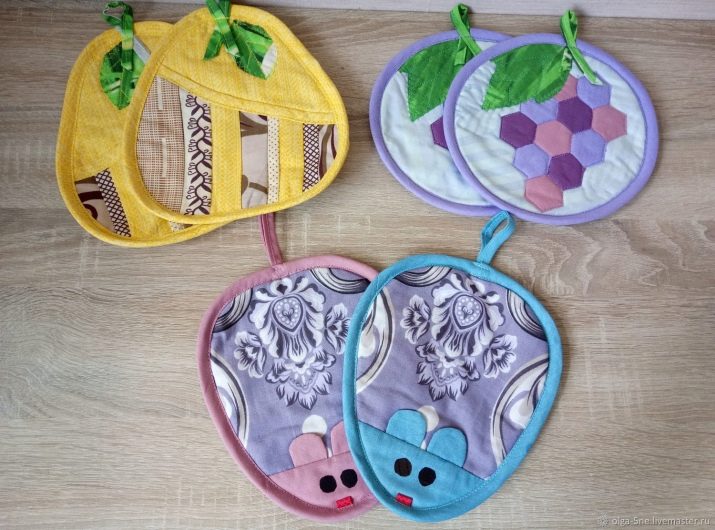
What it is?
The history of the origin of the potholder goes far into the past, and it is no longer possible to calculate its first inventor. However, it can be assumed that the first potholders could appear immediately after a person began to cook food with fire. Probably, at first it was scraps of fabric or something else. Maybe they were made of animal fur and skin, and only later the potholder turned not only into a functional attribute, but also into a decorative accessory. They began to be made from pieces of yarn and other scraps of materials, decorated with lace, and then they began to embroider drawings and ornaments on them.
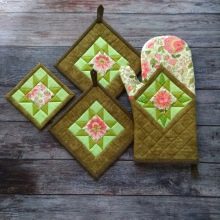
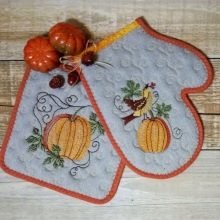

In the 40s of the last century, shops began selling whole sets, including an apron, towel, basket and potholder, made in one design. Such sets filled the kitchen with coziness. In the 50s, diagrams and patterns for embroidery of potholders appeared in magazines, and now all the housewives began to make original hand-embroidered products. Making potholders was included in the educational program, the girls embroidered them in labor lessons. In addition, knitted products were also popular.
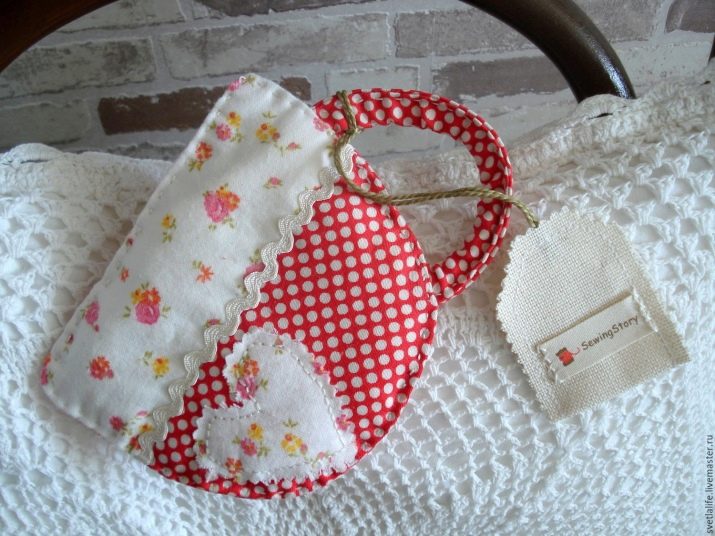
Thus, over the years and even centuries, the potholder has evolved from a cut of fabric into a fashionable stylish kitchen accessory that protects against burns. Many do not have oven mitts in the kitchen and use a kitchen towel instead, but the fabric of the towels is not designed to protect against burns. The towel has to be folded several times so as not to burn yourself for sure, while the product itself is quickly damaged during such use, loses paint, becomes unusable. Potholders are sewn from special materials in several layers, so their use is much more convenient and practical.
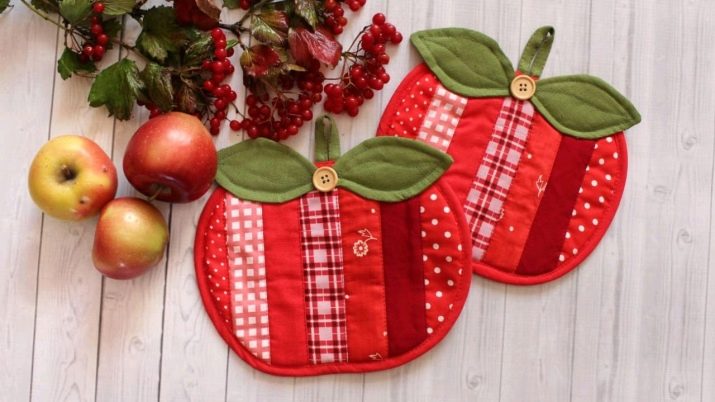
The potholder can be sewn on your own, bought or ordered at the atelier, and so that it gives the kitchen room a warm family mood, you can pair it with a teapot heating pad in the same style.
Some needlewomen manage to create painted potholders and paint a hot stand in the same design.
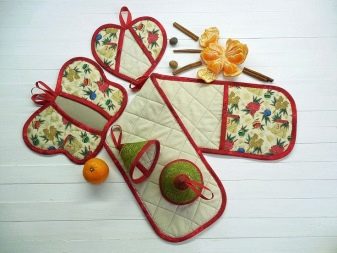
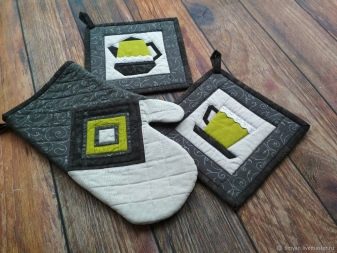
What are they?
Kitchen potholders are divided into two types.
Textile
This is a product made of fabric material. It can be sewn by yourself. Most often it is in the form of a mitten or in the form of a geometric figure. When choosing, give preference to potholders that are made from natural raw materials, for example, cotton, chintz, flax. If the product is based on synthetic materials, then it will quickly become unusable, since artificial fibers tend to melt when interacting with high temperatures. Natural fabrics tolerate contact with a hot object much better, they are more wear-resistant and durable.
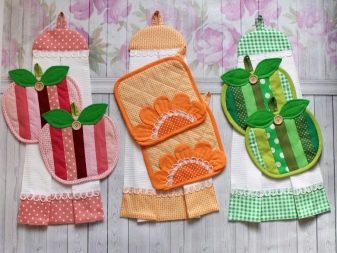
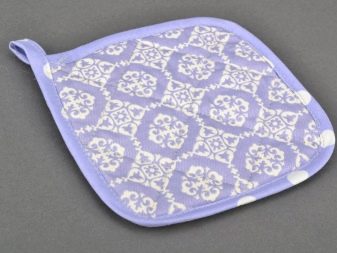
Another important factor when buying a textile potholder is the choice of filler. Usually batting, felt, drape, flannel play this role; they are used in the manufacture of products in several layers.
Avoid padding polyester as a filler, its thickness is achieved not by the density of the material, but by airiness, therefore it does not protect well from burns when it comes into contact with a hot surface.
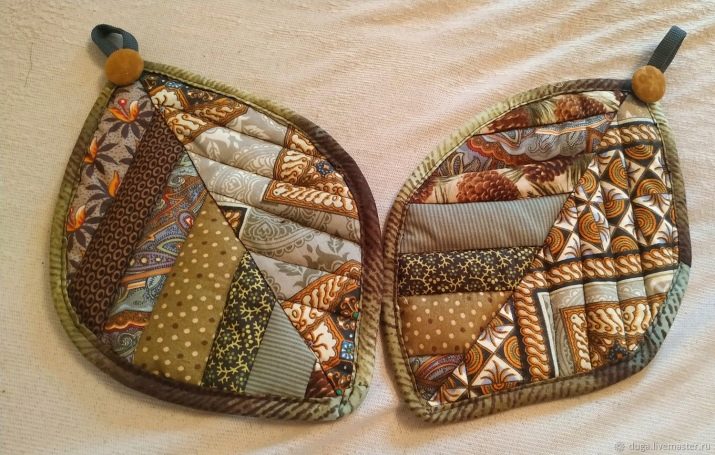
Silicone
This is a more modern type of potholder. Products made of silicone are less often used as decoration, but they perfectly fulfill their main function. Silicone potholders can also be manufactured in various shapes. This material has excellent performance properties.
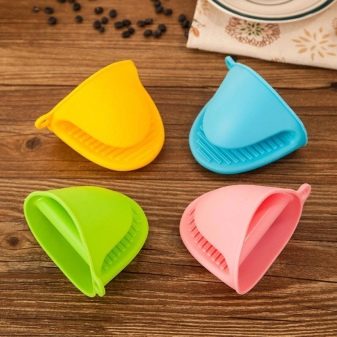
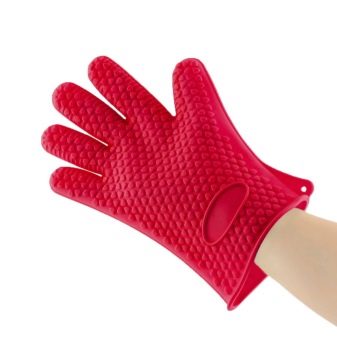
Form and appearance
Textile potholders are most often offered in square, round, triangular shapes, but you can choose or make a more original product, for example, in the form of a herringbone, strawberry, house, sunflower. However, in this case, the potholder will more serve as a decorative function, in addition, such an interesting product can be presented to mom, grandmother, girlfriend for a holiday. For operation, a textile tack of an unusual shape is not particularly convenient. Silicone options also have a variety of forms, and, unlike textile ones, the paints on them will not fade over time.

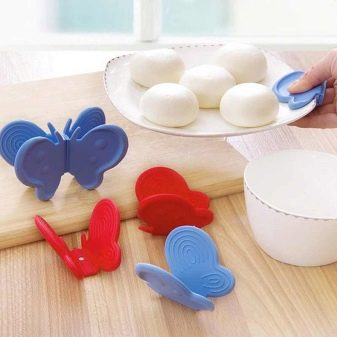
The most convenient form is a mitten, it provides comfortable work with a wide baking sheet. If you remove the lid from a hot pot or frying pan in such a mitten, then you can not be afraid that some of the contents will splash onto your hand, which cannot be said when using a regular square potholder.
Most often, such potholders are double or paired, that is, they are sold immediately on both hands.


Some needlewomen prefer to sew potholders in the form of animals, plants, trees. And since this product is intended for use in the kitchen, potholders in the form of fruits, vegetables, sweets, scrambled eggs, and a sandwich will be more appropriate options. For manufacturing, choose a material of the appropriate color and texture, as well as correctly position the parts on the product. Don't be afraid to get creative. Decorate the potholder with beads, beads, buttons and other accessories, but remember that these parts must be resistant to high temperatures and cannot scratch the surface of the cookware.
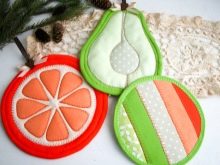
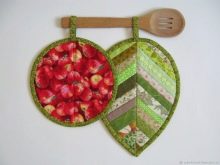

Nuances of choice
With an irresponsible approach to the choice of potholders, small, but very unpleasant consequences can occur. It could be a spoiled dish, or a burn or cut. When buying kitchen utensils, you need to pay attention to some of the properties of the products offered.
- Thermal conductivity. This is the main property that any potholder should have. But these days, most manufacturers still invest more resources in the appearance, especially with regard to fabric products. Silicone potholders conduct heat more slowly than synthetic or natural fabrics. They are able to withstand temperatures up to 300 degrees. Thus, if the hostess needs an item that is guaranteed to protect against burns, then give preference to silicone attributes.
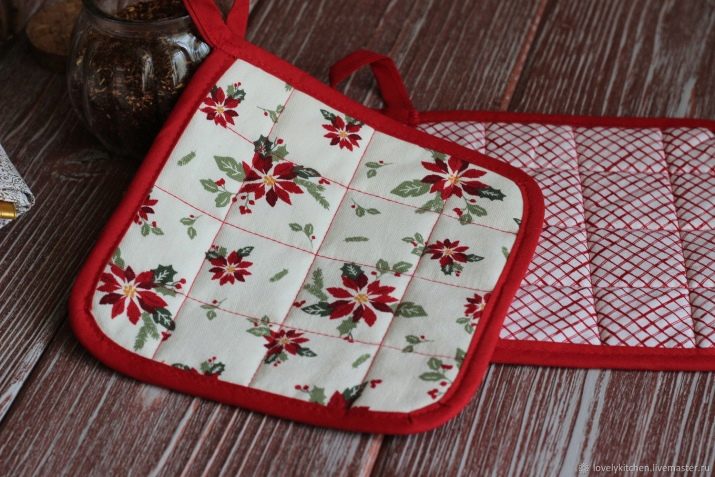
- Water permeability. Often, when working in the kitchen, housewives need to touch not only hot surfaces, but also wet ones. For example, water can get on the potholder while holding a pot in which water is poured, or the product can be accidentally left on a wet table. In this case, the textile potholder will quickly lose paint, the material will shrink, and it will no longer be possible to use it until it is completely dry. In this regard, the silicone product wins again, because it is not afraid of moisture, does not absorb water, and even if water gets on the surface, this will not affect the functionality of the tack in any way.
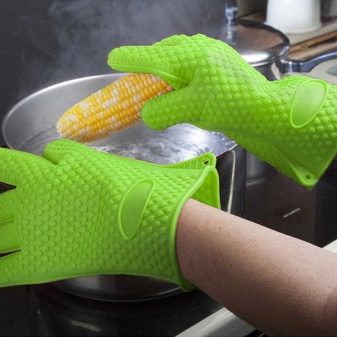
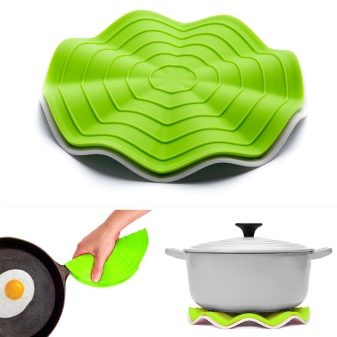
- Hanging eyelet. Pay attention to the presence of a hanging loop. The potholder should be suspended, since in this case it is in plain sight, it is easy to remove it, and if it gets wet, it will dry faster. Ears can be found in both silicone and fabric, but silicone versions can be purchased with a magnet instead of a loop. In this case, such a tack can be hung on any metal surface, for example, on a roof rack, hood or refrigerator.
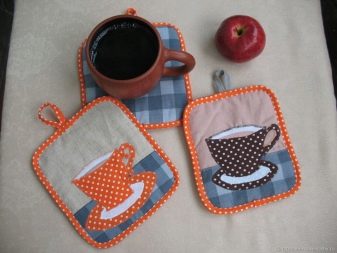
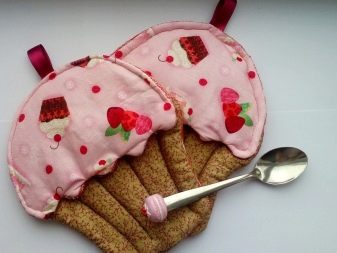
- The size. As for the size, then choose a product that will be convenient for you. Usually it is 18-20 cm wide and 20 cm high.
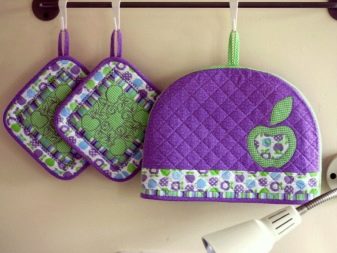
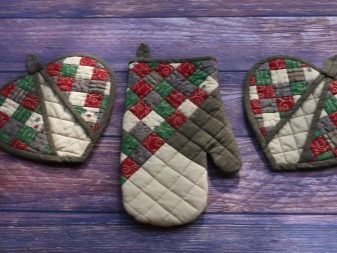
Usage Tips
Cloth potholders quickly lose their appearance. They often get grease stains that are difficult to remove, so most of these washed items quickly move from a prominent place to the closet with towels. But even if there is no external contamination, the potholder should be washed every three days, because this attribute is used in the kitchen.
You can wash them in the washing machine; for this, select the temperature setting for the towels. If this is a handmade potholder and there are decorative elements on it, for example, beads or beads, then it is better to soak it and then wash it by hand. But to iron such potholders after washing should be through the iron or at the minimum heating temperature of the iron.


Even if the product is not used and just hangs in the kitchen for decoration, it is still important to wash it regularly, because it accumulates dirt, dust, grease that can get on food. Dry the oven mitt well after washing. If you use a wet or damp jersey, you can get burned or ruin the potholder itself. Be sure to change frequently used potholders (every three months). In terms of care, the more modern silicone again wins.
This option does not need to be washed, it is enough to rinse with running water. This material does not absorb odors, and therefore relieves the hostess of the extra hassle of caring for potholders.
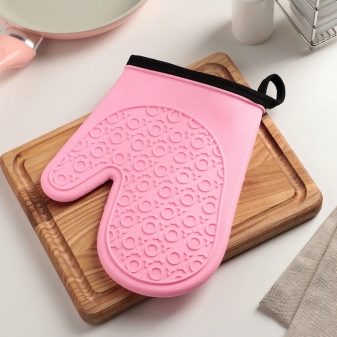

If the hostess cannot find an original version suitable for her kitchen in stores, then you can sew the product yourself. Moreover, you do not need to be a professional tailor for this. Even a novice hostess will cope with the task. The easiest way is to sew a mitten-shaped potholder: it is both simple and practical to use. When cutting, circle your palm with a pencil and add 3 cm on each side so that the mitten is not tight, but fits loosely.If square products seem comfortable, then they need to be cut according to the 20x20 cm scheme. This is the optimal size.
Let's consider sewing mittens in more detail.
- Cut out the four pieces as shown above. To keep your hand comfortable, choose a soft, pleasant fabric for the inner lining. The front side should be made of dense, bright material. And as a filler, for example, fleece is suitable.
- Fold the front pieces together, secure the filler on top, the next layer is the inner fabric. Sew the resulting structure, stepping back 5-7 mm from the edge. Carefully cut off the edges and carefully turn out the finished potholder.
- Take a strip of fabric or tape and work it over the mitten. Sew on the eyelet. Decorate the item with various accessories as needed.
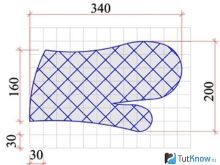
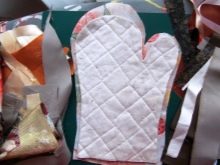
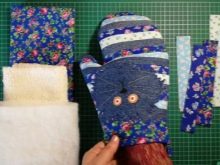
There are also more difficult options for sewing.
For example, a potholder made using the patchwork technique looks very original. Old denim pants are suitable for making it. Flaps made of material of different colors connected to each other will look beautiful.

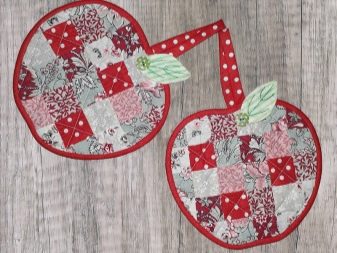
A self-made pot holder will decorate the kitchen better than purchased products, since its design will be matched to a specific interior. But do not forget that such an item will last less silicone options, and it is more difficult to care for it. But it can be given to a business woman for a holiday, and it will be an exclusive gift. The design can be timed to a holiday or a birthday girl's hobby. That is, a cat lover can be presented with a potholder in the form of a cute cat, and for those who adore martial arts, they can sew a product in the form of boxing gloves.
For information on how to make an oven mitt with your own hands, see the next video.


